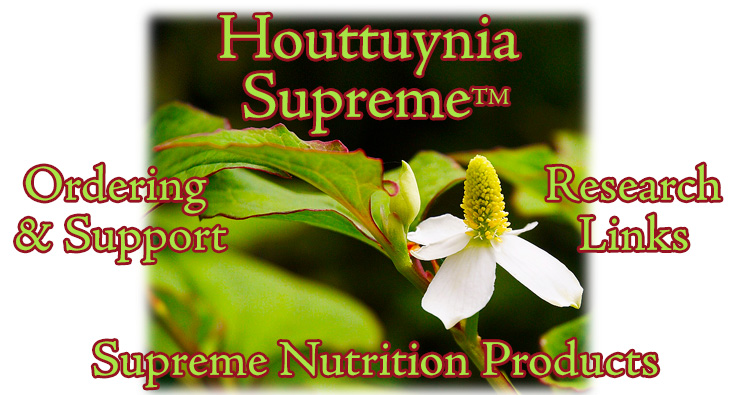
Houttuynia cordata is a flowering plant native to Asia, known as dokudami in Japan, which literally translates as poison blocking plant (the Chinese yúxīng cao; literally means “fishy-smell herb”). It is used as an edible garnish or salad green in parts of Asia and has been used medicinally for many centuries. As with most herbs it has many diverse uses and applications.
Houttuynia has at least 3 major anti-viral components: methyl n-nonyl ketone, lauryl aldehyde, and capryl aldehyde (at Supreme we prefer to provide dried plants in the ratios that nature provided them as opposed to standardized extracts) that have shown activity against herpes simplex type 1, influenza virus and HIV type ,1 along with most envelope virus in general (1,2).
Houttuynia shows strong anti-inflammatory properties (3) and is antioxidative, and anti-mutagenic (4). It helps with allergies by inhibiting histamine release and mast cell activation (5,6). It has been successfully used to down-regulate the production of Th2 cytokines (7).
Houttuynia has been shown to have inhibitory effects against cholinergic antagonists and should be considered in cases of cognitive impairment (8).
It has antibacterial properties including Salmonella (9), and is anti-parasitic (11).
The lyme community for many years has used Houttuynia to treat bartonella species (also often contracted from and by cats). It also has anti-fungal effects, including inhibiting candida albicans biofilms (10).
As with Morinda, Melia, Golden Thread, etc., etc, Houttuynia is a superb broad spectrum anti-microbial with many other therapeutic effects and should be considered with appropriate patients.
Dosage
1-2 scoops 3x per day
Contraindications
Do not take if pregnant or breast feeding.
References:
1. Hayashi, Kyoko, Mioko Kamiya, and Toshimitsu Hayashi. "Virucidal effects of the steam distillate from Houttuynia cordata and its components on HSV-1, influenza virus, and HIV." Planta medica 61.03 (1995): 237-241.
2. Chiang, Lien-Chai, et al. "Anti-Herpes simplex virus activity of Bidens pilosa and Houttuynia cordata." The American journal of Chinese medicine 31.03 (2003): 355-362.
3. Lu, H. M., et al. "Anti-inflammatory effect of Houttuynia cordata injection." Journal of Ethnopharmacology 104.1 (2006): 245-249.
4. Ya-Yen, C. H. E. N., et al. "A study of the antioxidative and antimutagenic effects of Houttuynia cordata Thunb. using an oxidized frying oil-fed model." Journal of nutritional science and vitaminology 49.5 (2003): 327-333.
5. Li, Guang Zhao, et al. "Inhibitory effects of Houttuynia cordata water extracts on anaphylactic reaction and mast cell activation." Biological and Pharmaceutical Bulletin 28.10 (2005): 1864-1868.
6. Han, Eun Hee, et al. "Houttuynia cordata water extract suppresses anaphylactic reaction and IgE-mediated allergic response by inhibiting multiple steps of FcεRI signaling in mast cells." Food and chemical toxicology47.7 (2009): 1659-1666.
7. Lee, Ji-Sook, et al. "Suppressive effects of Houttuynia cordata Thunb (Saururaceae) extract on Th2 immune response." Journal of ethnopharmacology 117.1 (2008): 34-40.
8. Huh, Eugene, et al. "Houttuynia cordata improves cognitive deficits in cholinergic dysfunction Alzheimer’s disease-like models." Biomolecules & therapeutics 22.3 (2014): 176.
9. Kim, Gon Sup, et al. "Biological and antibacterial activities of the natural herb Houttuynia cordata water extract against the intracellular bacterial pathogen salmonella within the RAW 264.7 macrophage." Biological and Pharmaceutical Bulletin 31.11 (2008): 2012-2017.
10. Sekita, Yasuko, et al. "Preventive Effects of Houttuynia cordata Extract for Oral Infectious Diseases." BioMed Research International 2016 (2016).
11. Yadav, Arun K. "Anticestodal activity of Houttuynia cordata leaf extract against Hymenolepis diminuta in experimentally infected rats." Journal of Parasitic Diseases 35.2 (2011): 190-194.
Back to the Supreme Nutrition Products Home Page